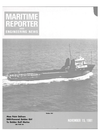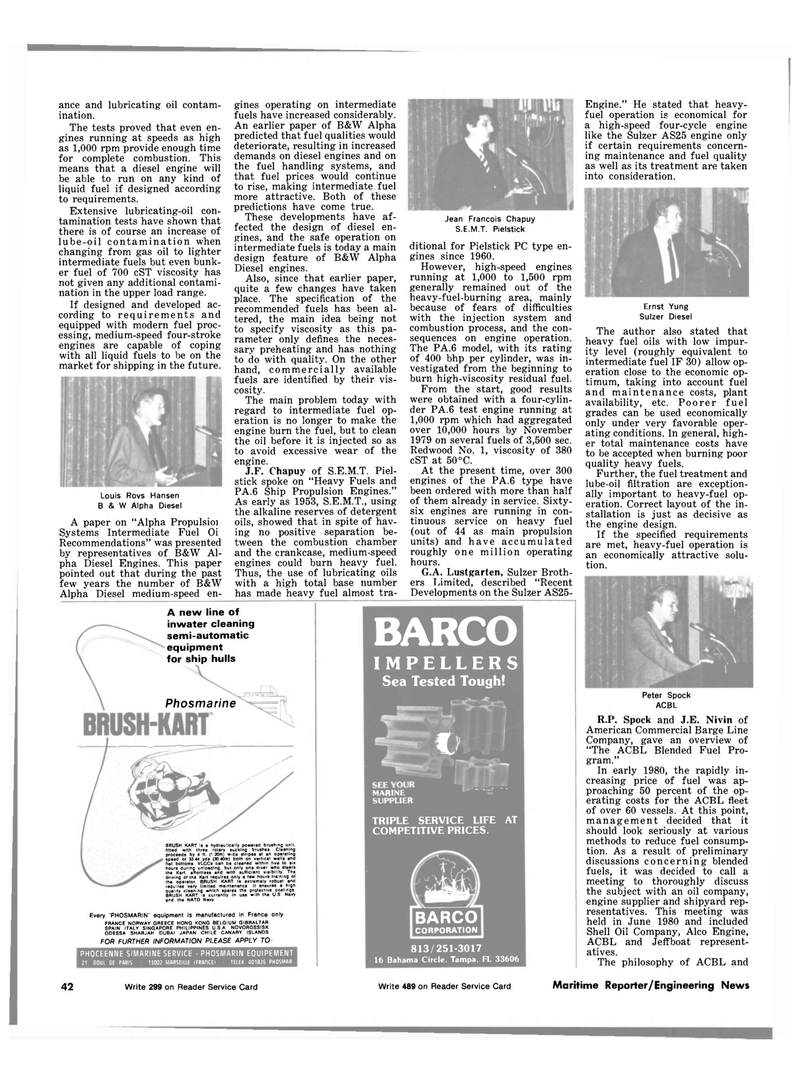
Page 38: of Maritime Reporter Magazine (November 15, 1981)
Read this page in Pdf, Flash or Html5 edition of November 15, 1981 Maritime Reporter Magazine
ance and lubricating oil contam- ination.
The tests proved that even en- gines running at speeds as high as 1,000 rpm provide enough time for complete combustion. This means that a diesel engine will be able to run on any kind of liquid fuel if designed according to requirements.
Extensive lubricating-oil con- tamination tests have shown that there is of course an increase of lube-oil contamination when changing from gas oil to lighter intermediate fuels but even bunk- er fuel of 700 cST viscosity has not given any additional contami- nation in the upper load range.
If designed and developed ac- cording to requirements and equipped with modern fuel proc- essing, medium-speed four-stroke engines are capable of coping with all liquid fuels to be on the market for shipping in the future.
Louis Rovs Hansen
B & W Alpha Diesel
A paper on "Alpha Propulsioi
Systems Intermediate Fuel Oi
Recommendations" was presented by representatives of B&W Al- pha Diesel Engines. This paper pointed out that during the past few years the number of B&W
Alpha Diesel medium-speed en- gines operating on intermediate fuels have increased considerably.
An earlier paper of B&W Alpha predicted that fuel qualities would deteriorate, resulting in increased demands on diesel engines and on the fuel handling systems, and that fuel prices would continue to rise, making intermediate fuel more attractive. Both of these predictions have come true.
These developments have af- fected the design of diesel en- gines, and the safe operation on intermediate fuels is today a main design feature of B&W Alpha
Diesel engines.
Also, since that earlier paper, quite a few changes have taken place. The specification of the recommended fuels has been al- tered, the main idea being not to specify viscosity as this pa- rameter only defines the neces- sary preheating and has nothing to do with quality. On the other hand, commercially available fuels are identified by their vis- cosity.
The main problem today with regard to intermediate fuel op- eration is no longer to make the engine burn the fuel, but to clean the oil before it is injected so as to avoid excessive wear of the engine.
J.F. Chapuy of S.E.M.T. Piel- stick spoke on "Heavy Fuels and
PA.6 Ship Propulsion Engines."
As early as 1953, S.E.M.T., using the alkaline reserves of detergent oils, showed that in spite of hav- ing no positive separation be- tween the combustion chamber and the crankcase, medium-speed engines could burn heavy fuel.
Thus, the use of lubricating oils with a high total base number has made heavy fuel almost tra-
Jean Francois Chapuy
S.E.M.T. Pielstick ditional for Pielstick PC type en- gines since 1960.
However, high-speed engines running at 1,000 to 1,500 rpm generally remained out of the heavy-fuel-burning area, mainly because of fears of difficulties with the injection system and combustion process, and the con- sequences on engine operation.
The PA.6 model, with its rating of 400 bhp per cylinder, was in- vestigated from the beginning to burn high-viscosity residual fuel.
From the start, good results were obtained with a four-cylin- der PA.6 test engine running at 1,000 rpm which had aggregated over 10,000 hours by November 1979 on several fuels of 3,500 sec.
Redwood No. 1, viscosity of 380 cST at 50°C.
At the present time, over 300 engines of the PA.6 type have been ordered with more than half of them already in service. Sixty- six engines are running in con- tinuous service on heavy fuel (out of 44 as main propulsion units) and have accumulated roughly one million operating hours.
G.A. Lustgarten, Sulzer Broth- ers Limited, described "Recent
Developments on the Sulzer AS25-
Engine." He stated that heavy- fuel operation is economical for a high-speed four-cycle engine like the Sulzer AS25 engine only if certain requirements concern- ing maintenance and fuel quality as well as its treatment are taken into consideration.
Ernst Yung
Sulzer Diesel
The author also stated that heavy fuel oils with low impur- ity level (roughly equivalent to intermediate fuel IF 30) allow op- eration close to the economic op- timum, taking into account fuel and maintenance costs, plant availability, etc. Poorer fuel grades can be used economically only under very favorable oper- ating conditions. In general, high- er total maintenance costs have to be accepted when burning poor quality heavy fuels.
Further, the fuel treatment and lube-oil filtration are exception- ally important to heavy-fuel op- eration. Correct layout of the in- stallation is just as decisive as the engine design.
If the specified requirements are met, heavy-fuel operation is an economically attractive solu- tion.
Peter Spock
ACBL
R.P. Spock and J.E. Nivin of
American Commercial Barge Line
Company, gave an overview of "The ACBL Blended Fuel Pro- gram."
In early 1980, the rapidly in- creasing price of fuel was ap- proaching 50 percent of the op- erating costs for the ACBL fleet of over 60 vessels. At this point, management decided that it should look seriously at various methods to reduce fuel consump- tion. As a result of preliminary discussions concerning blended fuels, it was decided to call a meeting to thoroughly discuss the subject with an oil company, engine supplier and shipyard rep- resentatives. This meeting was held in June 1980 and included
Shell Oil Company, Alco Engine,
ACBL and Jeffboat represent- atives.
The philosophy of ACBL and
A new line of inwater cleaning semi-automatic equipment for ship hulls
Phosmarine
BRUSH KART is a hydraullcally powered brushing unit, fitted with three rotary sucking brushes. Cleaning proceeds by 4 ft. (1.20m) wide stripes at an operating speed of 33.44 yds (30.40m) both on vertical walls and flat bottoms. VLCCs can be cleaned within five to six hours during unloading, but only one diver who steers the Kart, effortless and with sufficient visibility. The driving ot the Kart requires only a few hours training of the operator, BRUSH KART is extremely robust and requires very limited maintenance. It ensures a high quality cleaning which spares the prqtective coatings.
BRUSH KART is currently In use with the U.S. Navy and the NATO Navy
Every 'PHOSMARIN' equipment is manufactured in France only
FRANCE NORWAY GREECE HONG KONG BELGIUM GIBRALTAR
SPAIN ITALY SINGAPORE PHILIPPINES U S A. NOVOROSSISK
ODESSA SHARJAH DUBAI JAPAN CHILE CANARY ISLANDS
FOR FURTHER INFORMATION PLEASE APPLY TO:
PH0CEENNE S'MARINE SERVICE • PHOSMARIN E0UIPEMENT 21. B0UL DE PARIS 15002 MARSEILLE I FRANCE! • TELE* 401826 PH0SMAR
BARCO
IMPELLERS
Sea Tested Tough! t)
MARINE
SUPPLIER - - - •-
TRIPLE SERVICE LIFE AT
COMPETITIVE PRICES.
BARCO
CORPORATION 813/251-3017 16 Bahama Circle. Tampa. FL 33606 42 Write 299 on Reader Service Card Write 489 on Reader Service Card Maritime Reporter/Engineering News

 37
37

 39
39
